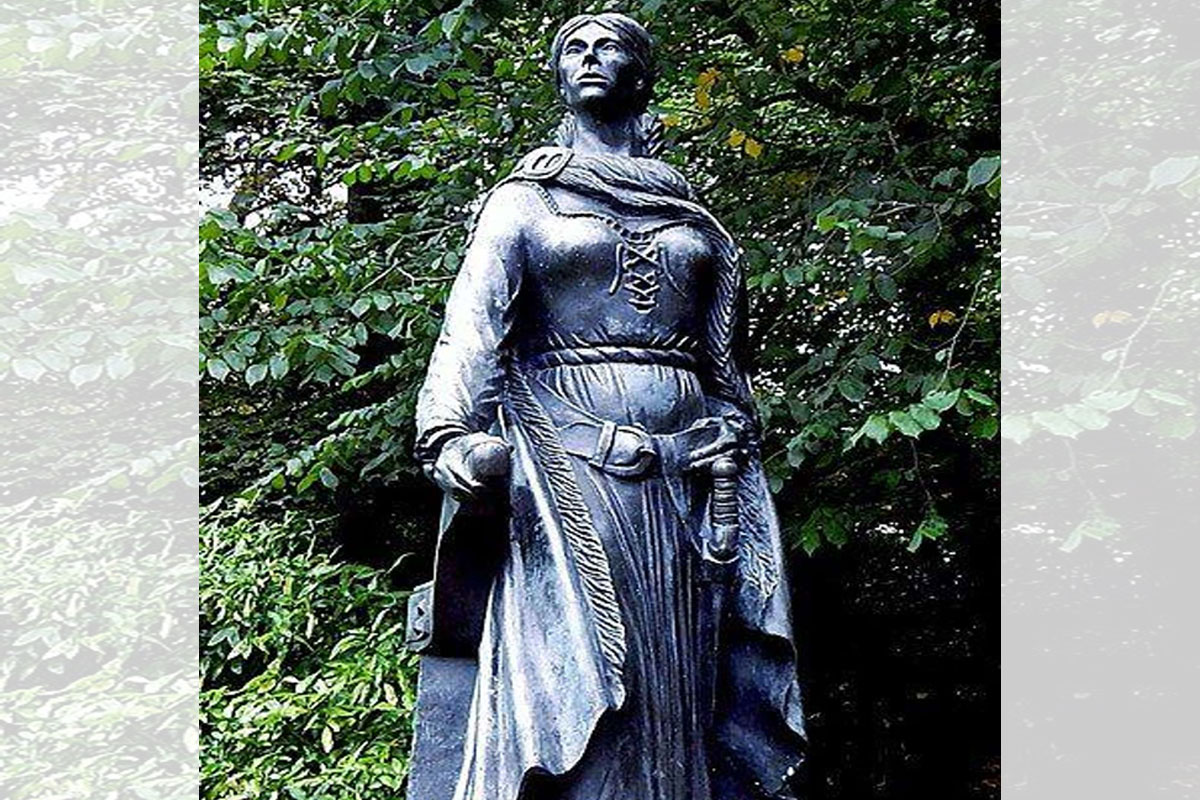
Who Is The Toughest Female Warrior In History?
Melissa Sartore
When it comes to pitting warriors against each other on the battlefield, it’s common to think of men. Yet there have been countless women warriors throughout history. From the ancient world through modern times, female fighters have exhibited great strength, skill, and intelligence – rivaling, and even besting, their male counterparts.
What would happen if some of the toughest female fighters of all time faced off? Who would win? And which one would you be most terrified to face
________________________________________
• Photo: Suzanne Mischyshyn / Wikimedia Commons / CC BY-SA 2.0
 Grace O’Malley
Grace O’Malley
When And Where: Born in County Mayo in western Ireland around 1530, Grace O’ Malley (Grainne Mhaol Ni Mhaille) was a member of the seafaring O’Malley clan. After being told she couldn’t work as a sailor because she was a girl and the daughter of a clan chief, O’Malley cut her hair, dressed like a boy, and took to the high seas.
At the age of 15, she married Donal O’Flaherty, the son of the chief of the O’Flaherty clan. She had three children with Donal, who passed away when O’Malley was 23. After her husband’s death, she assumed control of his lands and ships before returning to County Mayo. She married again in 1566 and bore one son.
Her Greatest Accomplishments:
o In 1567, O’Malley supposedly led her crew to victory over Algerian pirates just one hour after giving birth to her fourth child, Tiobold (Theobold).
o With the passing of her father, O’Malley became the queen of her clan.
o Through raids and piracy, O’Malley amassed great wealth and power and held numerous castles throughout Ireland.
o In 1574, O’Malley fought off English raiders at her stronghold, Rockfleet Castle.
o She possessed between three and 20 ships, with 100-200 men under her command.
o When English governor Sir Richard Bingham seized her property, arrested her son and brother, and threatened to slay her family if she didn’t cease pirate activities, O’Malley pleaded to Queen Elizabeth I for assistance. After receiving a questionnaire of sorts from the Queen, O’Malley sailed to London and demanded an audience with the monarch.
o When O’Malley met with Queen Elizabeth in 1593, she allegedly refused to bow. She considered herself to be an equal, not a subject. She presented her case so well that the Queen ordered O’Malley’s son and brother to be released.
How She Went Out: O’Malley passed in 1603, the same year as Queen Elizabeth I, most likely at Rockfleet Castle.
• Is she the toughest?
• • • Photo: Smena Magazine / Wikimedia Commons / Public Domain
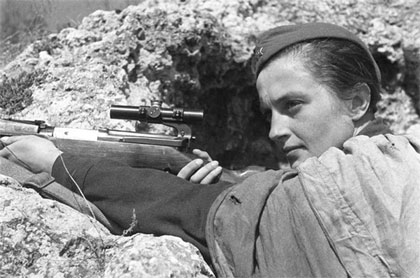 Lyudmila Pavlichenko
Lyudmila Pavlichenko
When And Where: During WWII, Lyudmila Pavlichenko served as one of Soviet Russia’s most dangerous snipers. Born in a small town near Kyiv in 1916, Pavlichenko worked at an arsenal and practiced shooting at a local club before joining a paramilitary organization as a young woman. At the age of 24, Pavlichenko joined the Red Army – but only after they made her showcase her firing skills in an audition of sorts.
Her Greatest Accomplishments:
• Pavlichenko was sent into combat in August 1941, where she took down her first two enemy combatants. Over the subsequent two and a half months, she eliminated 185 more.
• By June 1942, she had recorded 309 kills with her Tokarev SVT-40 semi-automatic rifle.
• After being injured four times and experiencing what is now called post-traumatic stress disorder, Pavlichenko was sent on a press tour, and visited the United States.
• She met Franklin and Eleanor Roosevelt, received gifts from admirers at every stop, and, when she returned to Russia, was awarded the Hero of the Soviet Union distinction.
• She trained snipers for the rest of WWII, but never returned to combat.
How She Went Out: Pavlichenko went back to university at Kyiv, where she had been studying history. She earned her degree and worked for the Soviet Navy Headquarters as a researcher. She passed in 1974, reportedly swearing like a sailor while her son held her in his arms.
• Is she the toughest?
• • Photo: Joseph Martin Kronheim / Wikimedia Commons / Public Domain
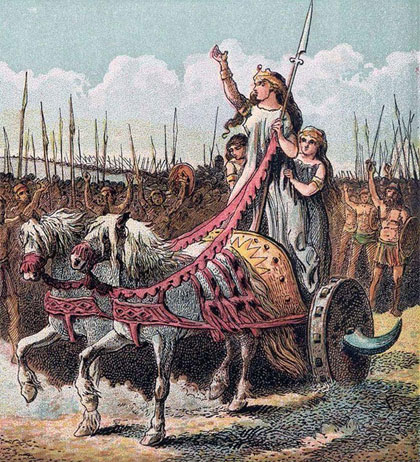 Boudica
Boudica
When And Where: As the wife of King Prasutagus of the Iceni tribe in Britain, Boudica watched her husband become a client king of Rome. Prasutagus cooperated with Rome after the empire invaded in 43 CE, and he served as Rome’s ally until his passing in 60 CE. When Prasutagus perished, the Roman administration took over Iceni land and brutalized Boudica and her daughters in the process. According to Tacitus, Boudica vowed “nothing is safe from Roman pride and arrogance. They will deface the sacred and will deflower our virgins. Win the battle or perish, that is what
I, a woman, will do.”
Her Great Achievements:
• Boudica first struck Camulodunum, modern Colchester. With support from the neighboring Trinovantes tribe, she attacked the Roman colony’s inhabitants. With little resistance from the Romans (the governor was warring on the island of Anglesey), she then pushed onto Londinium, the location of modern-day London.
• After the Celtic queen sacked Verulamium, now St. Albans, Tacitus claims “unprecedented numbers” of Roman and Briton forces met on the battlefield.
• Boudica shocked the Romans with her ability to lead, destroyed several major Roman settlements, and slayed numerous Romans in the process.
How She Went Out: Boudica was defeated by Suetonius, which Tacitus termed a “glorious victory,” for the Romans. The writer estimated “almost 80,000 Britons fell,” compared to 400 Romans slain and “a slightly larger number” wounded. Following her defeat, Boudica drank poison to avoid capture.
• Is she the toughest?
• • Photo: Wikimedia Commons / Public Domain
Did you know?
Nakano Takeko fans upvote Lozen on this list
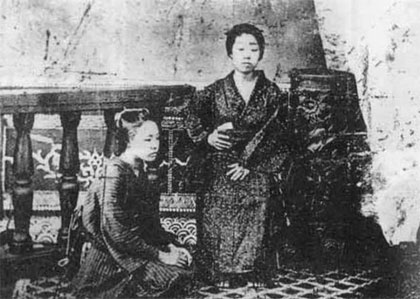 Nakano Takeko
Nakano Takeko
When And Where: As one of Japan’s Onna-Bugeisha, or female samurai, Nakano Takeko fought and perished during the Meiji Restoration of the 19th century. Born in 1847, Nakano grew up as a member of Aizu clan and was the daughter of a samurai. She learned the naginata, or pole weapon, in her youth, and when imperial troops threatened Wakamatsu castle in October 1868, she stood strong with 3,000 fellow warriors to defend her lands.
Her Greatest Achievements:
• At the siege of Wakamatsu castle in 1868, Nakano Takeko led between 20 and 30 women samurai (the Joshitai) in a counter-attack against the imperial army – a force some 30,000 strong.
• Armed with a naginata, she took on soldiers equipped with firearms and slew at least five enemy combatants.
• After being shot by one of the imperial troops, Nakano instructed her sister, Masako, to cut off her head so it would not be used as a trophy.
How She Went Out: Nakano Takeko perished at the siege of Wakamatsu castle, and her sister did cut off her head. Her head was buried at a temple in Aizu.
• Is she the toughest?
• • Photo: Wikimedia Commons / Public Domain
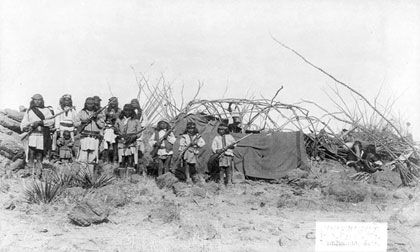 Lozen
Lozen
When And Where: Born around 1840, Lozen was the sister of Victorio, the chief of the Chihenne Apache tribe. The name Lozen means “dexterous horse thief,” denoting some skill with horses, but Lozen was also trained as a medicine woman. She fought alongside her brother, Victorio, who called her “strong as a man, braver than most, and cunning in strategy, Lozen is a shield to her people.”
Lozen witnessed fighting between the Apache and the Mexican government throughout her life. Following the 1848 Treaty of Guadaloupe Hidalgo, she found herself under the authority of the United States.
Her Greatest Accomplishments:
• Lozen was raised with the same kinds of physical training as Apache boys, learning hunting and archery. She was said to have had such foot speed that she could out-race her male counterparts.
• After she reached puberty, she reportedly received supernatural powers to heal wounds and identify the location of enemies.
• In 1877, Lozen left the San Carlos Reservation with a group of Apache and was on the run for three years. Once Victorio and his band were destroyed by Mexican forces, she joined Geronimo’s rebel group.
• She demonstrated her abilities by detecting enemies and fighting alongside her male counterparts.
• In the final escape from the San Carlos Reservation in 1885, she fought with Geronimo and fled after he negotiated a surrender.
How She Went Out: Ultimately forced to surrender to General George Crook and the United States military in 1886, Lozen was kept as a prisoner of war. Sent by train to Florida, she arrived in Alabama in 1888 where she passed of the “coughing sickness” (most likely tuberculosis) in 1889 or 1890.
• Is she the toughest?
• • Photo: Jules Eugène Lenepveu / Wikimedia Commons / Public Domain
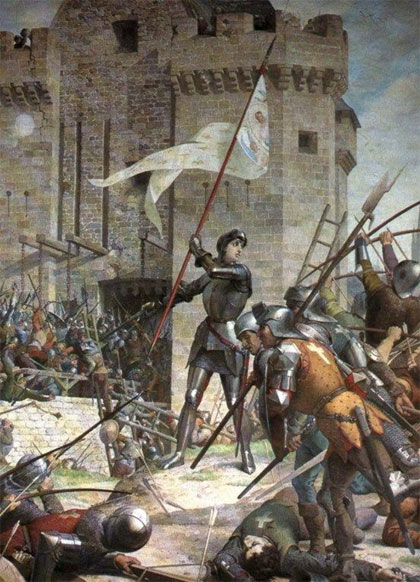 Joan of Arc
Joan of Arc
When And Where: During the Hundred Years’ War (1337-1453), Joan of Arc believed she was tasked by God to lead the French to victory. Born to a peasant family in 1412, Joan had her first divine revelation at the age of 13. She received an audience with a local captain, Robert de Baudricourt, and asked to see the embattled king, Charles VII. He sent her away on numerous occasions before she finally met with the crown prince. After some convincing, Charles was taken with Joan’s story. He sent her to Orleans in March 1429.
Her Greatest Accomplishments:
• The siege at Orleans had lasted for months. When Joan arrived, she rode a white horse and wore white armor, and led French assaults against the English and Burgundian forces. Despite being wounded, she galvanized the French forces, who broke the siege and claimed a victory for the dauphin and his troops in May 1429.
• From Orleans, Joan went on the Loire Campaign of 1429. The effort proved so successful the French took Rheims. When Charles was crowned in Rheims in July 1429, Joan of Arc was by his side.
• In 1920, Joan of Arc was canonized by the Catholic church.
How She Went Out: Charles continued to send Joan of Arc into combat until she was captured in Compiegne in 1430. The Burgundians who took her prisoner ransomed her to the English for 10,000 francs. Once in English custody, Joan was accused of heresy. Brutalized, humiliated, interrogated, and put on trial, she was found guilty and burned at the stake on May 30, 1431.
• Is she the toughest?
• • Photo: Wikimedia Commons / Public Domain
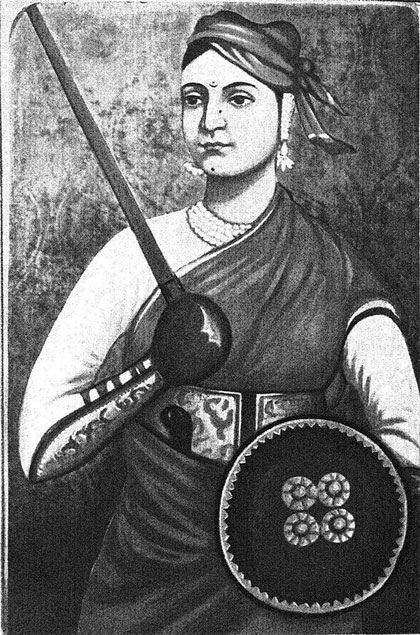 Rani Lakshmibai
Rani Lakshmibai
When And Where: Born in 1827 to a Brahmin family in India, Lakshmibai spent her childhood learning martial arts and sword skills. Born Manikarnika Tambe, she lost her mother at a young age and was raised by her father at the court of Peshwa. She married Gangadhar Rao Newalkar, the Maharaja of Jhansi, in 1842 and took the name Rani Lakshmibai.
After the passing of her husband in 1853, the British refused to acknowledge the succession of the royal couple’s adopted son and cousin, Damodar Rao. Instead, they seized Jhansi on behalf of the East India Company under the Doctrine of Lapse.
Her Great Achievements:
• Lakshmibai refused to accept the British action and challenged it in court several times.
• When the “Great Rebellion” of 1857 erupted, Rani Lakshmibai promised British troops safe passage out of Jhansi. Unfortunately, after dozens of British were massacred, she was blamed for their brutal passings.
• After the Great Rebellion, the British threatened to invade Jhansi to restore order, prompting Lakshmibai to gather troops, supplies, and even ally with her neighbors to defend her lands.
• When Major General Sir Hugh Rose laid siege to Jhansi in March 1858, the rani reportedly donned a breastplate and a sword while carrying two revolvers.
• After several weeks of siege, Rani Lakshmabai fled Jhansi with her son, 10-year-old Domadar Rao, strapped to her back.
• She met up with fellow resistance leaders Tatia Tope, Nana Sahib, and Rao Sahib, before retreating to Gwalior. Once there, the pro-British Maharaja’s own troops joined their cause.
How She Went Out: In her final stand against General Rose and the British army at Morar, Rani Lakshmibai was slain in combat. On June 17, 1858, she was supposed to have been knocked off her horse and wounded before being shot. She became a martyr for India and was compared to Joan of Arc by General Rose. He reported to his commanding officer that Lakshmibai was “remarkable for her bravery, cleverness, and perseverance; her generosity to her subordinates was unbounded. These qualities, combined with her rank, rendered her the most dangerous of all the rebel leaders.”
• Is she the toughest?
• • Photo: Mihály Zichy / Wikimedia Commons / Public Domain
Did you know?
Tamar of Georgia fans upvote Joan of Arc on this list
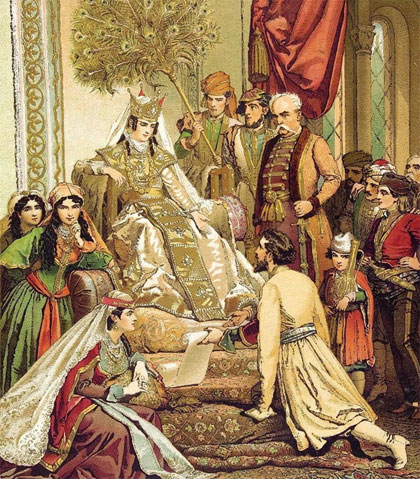 Tamar of Georgia
Tamar of Georgia
When And Where: Born around 1160, Tamar was the oldest daughter of King George III of Georgia. She became co-ruler with her father in 1178 and, after George III passed in 1184, assumed the thone.
Her Great Achievements:
• Queen Tamar sent her first husband, George Bogolyubsky, into exile in 1189 due to his drinking and impropriety. He later led a revolt against her, only to be defeated and sent back into exile. He staged a second uprising against Tamar in 1194, and was defeated again.
• Between 1193 and 1195, Tamar expanded her kingdom by leading a Georgian army into modern-day Armenia and Azebaijan several times.
• She defended Georgia against a Muslim coalition at Basiani in 1203.
• When the Emir of Arbadil in northern Iran attacked Georgia in 1209, he slayed and enslaved thousands of people. Queen Tamar responded by attacking and slaying the Emir and enslaving thousands in kind.
How She Went Out: Queen Tamar of Georgia passed in 1212 after leading another campaign into the Caucasus. She was succeeded by her son, George IV. The site of her burial is unknown, but she is considered a saint within the Antiochian Orthodox church.
• Is she the toughest?
• • Photo: Herbert Gustave Schmalz / Wikimedia Commons / Public Domain
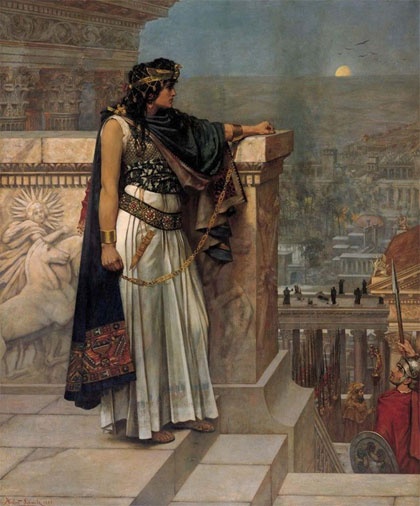 Zenobia
Zenobia
When And Where: Born around 240 CE, Zenobia was a Roman citizen of possibly Greek or Arab descent. According to sources, she was a skilled horseworman, fluent in several languages, and had a high tolerance for alcohol and hard work. She married Odaenthus, the governor of Syria, in 258, and soon gave birth to their son, Vaballathus.
After Odaenthus was slain in 266 or 267, Vaballathus succeeded his father and Zenobia served as his regent.
Her Greatest Achievements:
• With Rome in a weakened state, Zenobia moved to form her own empire shortly after becoming regent. She annexed surrounding areas and amassed an army, led by general Zabas, to invade Roman Egypt.
• After taking Egypt, Zenobia’s defiance of Rome caught the attention of Emperor Lucius Domitius Aurelianus. By 271, the same year Zenobia declared her son to be Caesar (ruler of Rome), Zenobia controlled roughly one-third of the Roman Empire.
• In 272, Zenobia’s army faced Aurelian’s at Palmyra. During the Roman siege of the city, she purportedly sent a note to the Emperor that read: “You demand my surrender as though you were not aware that Cleopatra preferred to die a queen rather than remain alive, however high her rank.”
How She Went Out: Palmyra fell and Zenobia was taken captive after attempting to flee east. After her defeat at Palymra in 272, Zenobia was taken to Rome where she was “led in triumph” for all to see. According to sources, Aurelian was not willing to slay a woman, and so Zenobia lived out her days in Rome. By other accounts, she was beheaded once she arrived at the city she’d always wanted to see.
• Is she the toughest?
• • Photo: Maître de la Mazarine / Wikimedia Commons / Public Domain
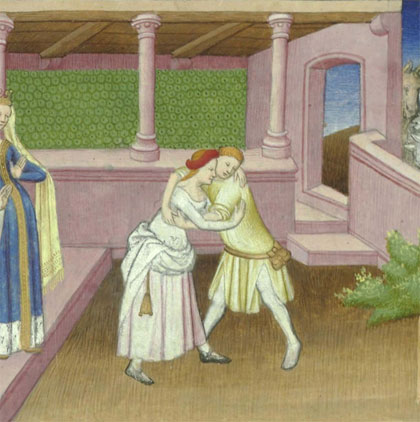 Khutulun
Khutulun
When And Where: Also called Aigiarm, among other names, Khutulun was the daughter of King Kaidu, the great-grandson of Ghengis Khan and ruler of parts of the Mongolian empire for much of the 13th century. Khutulun, born around 1260, was described as both strong and beautiful, and trained in traditional Mongol activities like horsemanship and archery. She was also said to be a skilled wrestler.
Her Greatest Accomplishments:
• Khutulun wrestled her potential suiters, and demanded 100 horses for each time they were defeated. According to Marco Polo, Khutulun “gained more than 10,000 horses” in the process.
• Marco Polo also described the princess as “so well-made in all her limbs, and so tall and strongly built, that she might almost be taken for a giantess.”
• Khutulun fought alongside her father. Polo wrote that, in battle, the princess would “dash at the host of the enemy, and seize some man thereout, as deftly as a hawk pounces on a bird, and carry him to her father; and this she did many a time.”
• When asked by her parents to throw one of her wrestling matches so she could find an appropriate suitor, she beat the prince anyway. He was so humiliated he left behind 1,000 horses instead of the usual 100.
How She Went Out: To dispel rumors that her stubborn refusal to marry was the result of an incestuous relationship with her father, Khutulun married a man named Abtakul and bore him two sons. It was said that her father wanted Khutulun to succeed him as khan, but she simply wanted to command his military. Khutulun passed in 1306, but the specifics of her final years are unknown.
• Is she the toughest?
• Photo: Edmund Ollier / Wikimedia Commons / Public Domain
 Cynane
Cynane
When And Where: Half-sister to Alexander the Great (d. 323 BCE), Cynane was the daughter of Philip II of Macedon and Audata, an Illyrian Princess. Illyrians believed that women were equal to men, and Audata trained Cynane in martial arts, horseback riding, and hunting.
Her Greatest Accomplishments:
• Cynane fought on her father’s military campaigns, supposedly alongside her brother Alexander.
• She trained her own daughter, Adea, to fight as well.
• After the passing of Alexander the Great, Cynane gathered forces to try to force the marriage of her daughter, Adea, and her half-brother, Arridaeus (later Philip III).
• While attempting to manipulate the nuptials, one of Alexander’s former generals, Antipater, was sent by the power-hungry Perdiccas to attack her forces at Strymon. Cynane proved victorious but Perdiccas sent another force led by his brother, Alcetus.
• According to Polyaenus, a 2nd century author, “The Macedonians at first paused at the sight of Philip’s daughter, and the sister of Alexander: while after reproaching Alcetas with ingratitude, undaunted at the number of his forces, and his formidable preparations for battle, she bravely engaged him; resolved upon a glorious passing, rather than, stripped of her dominions, accept a private life, unworthy of the daughter of Philip.”
How She Went Out: Unfortunately, Alcetus bested Cynane and she was slain before a formal battle took place. It’s said the Macedonia troops were so shocked at Cynane’s slaying by Alcetus that the marriage of her daughter to Arridaeus went ahead as planned. In the end, Perdiccas approved it to try to ease tensions created by Cynane’s death.
• Is she the toughest?
• • Photo: Wikimedia Commons / Public Domain
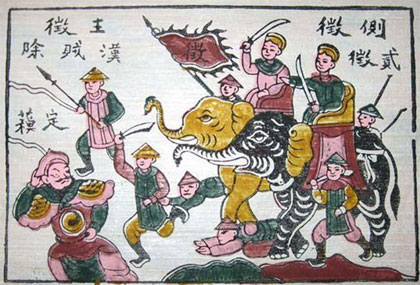 Trung Sisters
Trung Sisters
When And Where: Trung Trac and Trung Nhi, known as the Trung sisters, fought against the Chinese Han dynasty during the 1st century CE. Determined to maintain Vietnam’s independence in the face of Chinese imperial authority, their revolutionary efforts lasted for several years. After Trung Trac’s land-holding husband, Thi Sach, was slain by a Chinese general, Trung Trac retaliated.
She enlisted her sister and several other nobles in a march on the Chinese-held Lien Lau.
Their Greatest Accomplishments:
• The Trung sisters’ attack on Lien Lau in 39 CE resulted in the Chinese general fleeing the city.
• During the subsequent months, the sisters captured and held 65 strongholds in North Vietnam.
• Trung Trac was declared queen of a new, independent kingdom.
• According to sources, “Their success lasted for a couple of years until the Han sent their great general Ma Yuan (Mã Viện) south to crush the resistance. The sisters are believed to have killed themselves upon their defeat. Their spirits have continued as powerful cult figures to the present day.”
How They Went Out: With a large Chinese force sent to quash their rebellion, Trung Trac and Trung Nhi’s supporters abandoned them. Both women were captured by the Chinese. By some accounts they were executed, by others they took their own lives.
• Is she the toughest?
• • Photo: Chris Gyford / Wikimedia Commons / CC BY-SA 2.5
 Fu Hao
Fu Hao
When And Where: During the 12th or 13th century BCE, Fu Hao was not only one of Emperor Wu Ding’s wives, she was also a military general (perhaps China’s first). Much of the information about Fu Hao comes from her tomb, which was unearthed at Anyang in 1976, and from oracle bones dating to the Shang dynasty (c. 1600-1050 BCE).
Her Greatest Achievements:
• Fu Hao’s tomb contained 130 weapons made of bronze. Additional items made of jade, stone, ivory, and bone attested to her military importance. Her name was inscribed on four copper axes as well.
• The details of her actions on the battlefield, as written in oracle bone text, claim she fought against the Tu Fang and “recruited 3,000, and with 10,000 campaigned against the Qiang.”
How She Went Out: Soon after the successful Shang campaign against Ba Fung, Fu Hao returned to Anyang, took ill, and passed away. She may have been exhausted and, in part, heartbroken by the recent passing of her son, Xiao Yi. There is evidence that after she perished, Wu Ding made sacrifices to his wife at her tomb.
• Is she the toughest?
• • Photo: Mai Ngọc Xuân / Wikimedia Commons / Public Domain
 Triệu Thị Trinh
Triệu Thị Trinh
When And Where: In Vietnam during the 3rd century CE, the woman who came to be known as Lady Triệu led an uprising against China. She was an orphan, raised by her brother and trained in martial arts.
Her Greatest Accomplishments:
• At the age of 19 or 20, Triệu became so annoyed with her sister-in-law she slayed her and went into exile.
• She fought with her brother when he resisted Chinese oppression, and took up his revolutionary efforts when he was slain.
• In 248 CE, she led the Vietnamese uprising from atop an elephant, marching from Chinese stronghold to Chinese stronghold, slaying district officials and amassing thousands of followers.
How She Went Out: The Chinese sent 8,000 troops to combat Lady Triệu. According to legend, when the Chinese troops advanced unclothed, Triệu and her soldiers retreated in shame. Triệu later took her own life.
• Is she the toughest?
• • Photo: Wikimedia Commons / Public Domain
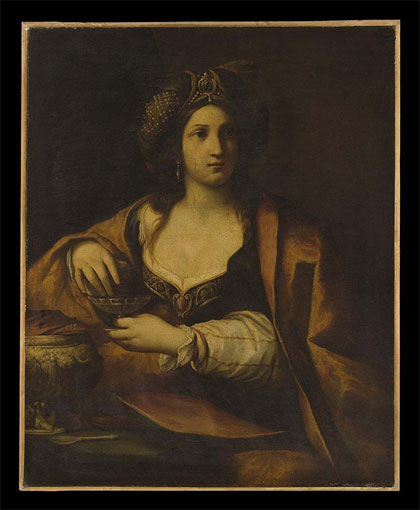 Artemisia I of Caria
Artemisia I of Caria
When And Where: The daughter of King Lygdamis of Halicarnassus, Queen Artemisia I of Caria ruled as regent for her young son, Pisindelis. During the 5th century BCE, Artemisia was an active participant in the wars between Greece and Persia, allying with whichever one suited her needs.
Her Greatest Achievements:
• At the Battle of Artemisium in 480 BCE, Artemisia flew the flag of whichever side seemed to be winning.
• Soon after, she counseled the Persians to avoid naval war and to attack Athens instead. According to Herodotus, she implored him to “not rush into a sea battle, master, but keep your fleet here close to shore… if you rush into a sea battle straight away, I am afraid that the defeat of the fleet will cause the land army to come to grief as well.” Xerxes considered her advice well-presented, but the Persians found themselves in a naval conflict at Salamis.
• Artemisia commanded a fleet of ships on behalf of the Persian ruler. However, when her ships were trapped between Greek and Persian forces, she rammed a Persian ship to escape. Her actions, misunderstood by Xerxes, earned her praise from the Persian king. He thought his ship was sunk by the enemy.
• When faced with what to do next, Xerxes asked Artemisia, whom he perceived to be a brilliant strategist, instead of his other advisors. She told him to withdraw from Greece since he had accomplished his goal – destroying the city of Athens.
How She Went Out: There’s no record of Artemisia I after the Battle of Salamis. One legend holds that, after she helped usher Xerxes’ sons to safety, she fell in love with a prince named Dardanus.
After Dardanus rejected her, she was so heartbroken that she ended her life.
Is she the toughest?
ranker.com




















